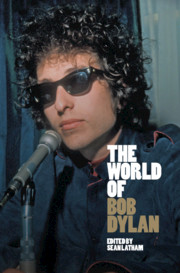Book contents
- The World of Bob Dylan
- The World of Bob Dylan
- Copyright page
- Contents
- Contributors
- Acknowledgments
- Introduction: Time to Say Goodbye Again
- Part I Creative Life
- Part II Musical Contexts
- Part III Cultural Contexts
- Part IV Political Contexts
- Part V Reception and Legacy
- Chapter 24 The Bob Dylan Brand
- Chapter 25 The Nobel Prize: The Dramaturgy of Consecration
- Chapter 26 Dylan: Stardom and Fandom
- Chapter 27 The Bob Dylan Archive®
- Further Reading
- Index
Chapter 26 - Dylan: Stardom and Fandom
from Part V - Reception and Legacy
Published online by Cambridge University Press: 21 April 2021
- The World of Bob Dylan
- The World of Bob Dylan
- Copyright page
- Contents
- Contributors
- Acknowledgments
- Introduction: Time to Say Goodbye Again
- Part I Creative Life
- Part II Musical Contexts
- Part III Cultural Contexts
- Part IV Political Contexts
- Part V Reception and Legacy
- Chapter 24 The Bob Dylan Brand
- Chapter 25 The Nobel Prize: The Dramaturgy of Consecration
- Chapter 26 Dylan: Stardom and Fandom
- Chapter 27 The Bob Dylan Archive®
- Further Reading
- Index
Summary
Bob Dylan was both a creature of the postwar explosion of celebrity culture and someone who played a major role in transforming it. From his earliest incarnations as a folksinger, Dylan showed an uncanny ability to manipulate the apparatus of publicity and fame. He continually transformed his persona as his songwriting and recording developed, and by the end of the 1960s, had become a star defined by his changes rather than the consistency of his persona. Yet, this did not mean that his fans or the large culture lacked a clear sense of him. Rather, as I argue in Rock Star, Dylan’s stardom remained the voice of youth in rebellion despite the fact that he had explicitly rejected protest songs as early as 1964.1 This disjunction between his variable personas and his relatively durable iconic significance belies a third level of concern: Dylan’s own identity. His fans and the larger public have consistently conflated identity and persona, one of the things that has fueled the seemingly unquenchable thirst for biographies and fanzines. How many other stars have their own “ologists”? We tend to assume that artists are trying to tell us who they really are. But Michel Foucault has suggested otherwise in speaking of his own work as a writer, “I am no doubt not the only one who writes in order to have no face. Do not ask who I am and do not ask me to remain the same: leave it to our bureaucrats and our police to see that our papers are in order.”2
- Type
- Chapter
- Information
- The World of Bob Dylan , pp. 313 - 324Publisher: Cambridge University PressPrint publication year: 2021

